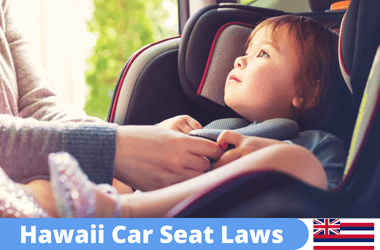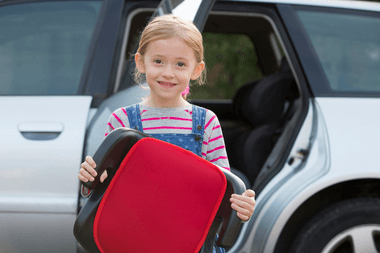What are the Hawaii Car Seat Laws?
Welcome to the Hawaii Car Seat Law Explained in Simple, Plain English!
If you have questions about the car seat laws in Hawaii, you have just found the perfect place for answers.
Look:
I’m a mom of 3 perfect little angles (when they are asleep, mostly), and we’re traveling a lot, so I have to be updated with all the car seat laws in different states. Plus, I was a paralegal in my past life, so I know how to translate lawyer jargon into text that can be easily understood even by the most sleep-deprived parent.
So this is why I’ve put together this article to let fellow parents know what the car seat rules in Hawaii are. I’ve written it in a way that anyone can understand with ease.
No matter your questions, you will find the answers below; let it be booster seat laws or rear forward-facing when is the time to switch or even if you need a car seat with taxis I have all this covered and more.
Let’s get started already!
[lwptoc]
By reading this article you agree that it’s for informational purposes and I can’t be held liable for the best advice ask the appropriate person.
Hawaii Booster Seat Laws
According to the booster seat law of Hawaii, all kids in the age range of 4 and 8 have to be secured in a booster car seat that is federally approved. The exception would be if the child is taller than 57” or weighs more than 40 pounds.
Hawaii Rear-facing Car Seat Laws
The law doesn’t specify how long you should keep your child in rear-facing mode. The law states that all kids have to be in a safety seat appropriate for them under four.
If we follow the AAP’s guidelines, then your baby should be rear-facing at least until their first birthday. In some states, they require this to be extended to age two.
It’s proven that rear-facing car seats are the safest so keep your kids like so as long as you can.
Hawaii Forward-facing Car Seat Laws
Again there are no details on when to upgrade to forward-facing mode. So the best thing to do is follow the manufacturer’s recommendations. As we know, rear-facing is the safest way to travel, so maximize it.
When the rear-facing car seat is outgrown, only then upgrade for a forward facing one.
Hawaii Taxi Car Seat Laws
In the state of Hawaii, taxis are exempt from the above car seat rules. Now, if you want to be extra safe, bring your own car seat because you can never know.
When Can My Child Sit in the Front Seat in Hawaii?
There’s no clear law on when you can move a child to the front seat. If we look at it from this point of view, then from the age of 8, when no car seat is needed, your child could go to the front of all the safety precautions are met.
However, according to the AAP, 13 years of age should be the first time a child should sit in the front.
Hawaii Car Seat Laws at a Glance
Here you can find the entire law in one place:
Car Seat Law (HRS Section 291-11.5)
Law: If you have a child under 4 years old, then they have to be secured in a car seat that meets all federal motor vehicle safety standards.
- If your child is between 4 and 8 years old when they have to use a booster seat until they are 57” tall or they weigh more than 40 pounds. If they reach these milestones, they can use the car seat belt in the back seat (or a RideSafer vest with a tether strap).
Location in car: There are no specifications where a child can or can’t sit
Taxi: In the state of Hawaii, taxis are exempt from the car seat rules. Now, if you want to be extra safe, make sure you bring your own car seat.
RideSafer legal: Yes. The Ride Safer travel vest qualifies for children at least age 3 and 30 pounds.
Fines: $100
Seat Belt Law
- Law: All passengers, including the driver, must wear a seat belt.
- Fine: $45 plus $20 surcharge
- RVs: The basic car seat law applies to RVs as well. All passengers have to use the seat belt and for kids, the appropriate car seat or restraint.
What is the law concerning Leaving kids in the Car in Hawaii?
It’s illegal in the state of Hawaii to leave a child unattended for more than 5 minutes. The law is quite clear that a child is considered anyone under the age of 9. And to be attended means that the second person should be above the age of 12.
Is it Illegal to Smoke in a Car with a Child in Hawaii?
Yes, it’s illegal to smoke and vape in a car when there’s a 13 or younger person aboard.
Conclusions on Hawaii Car Seat Laws
We have reached the end of this article, and I hope you have found what you’ve been looking for.
I’ve done my best to organize this article to cover the most common and important questions that parents have on their minds. Also, I’ve translated the dry lawyer jargon into something easy to understand.
Just in case I’ve missed something or you happen to have questions shoot me a message, and I will do my best to help you out.
Maybe you can help me out by sharing this post so other parents can know exactly how to keep their kids safe and avoid fines in the process. Thank You!
Are you thinking about visiting Washington?
Check out the most up-to-date Washington car seat laws to keep your kids as safe as possible. Knowing and implementing these policies may be life-saving.
Frequently Asked Questions:
Does a 7-year-old need a booster seat in Hawaii?
Yes, a 7-year-old will need a booster seat in the state of Hawaii. The law dictates that all kids between the ages of 4 and 8 have to be in a booster seat. The only exception would be if they are taller than 57” or weigh more than 40 pounds.
Do you need car seats in Hawaii?
Yes, you need car seats in Hawaii until the age of 8. Above the age of 8 you can use the seat belt to keep your kids safe.
When can my child stop using a booster seat in Hawaii?
A child can stop using a booster seat in Hawaii when they reach the age of 8, or their height exceeds 57 inches.
What are the age and weight requirement for a booster seat in Hawaii?
The age and weight requirements for booster seats in Hawaii are 40” height, 40 pounds weight and 4 years old. It’s basically the minimum requirements made by the manufacturer.
When can my child sit in the front seat according to Hawaii car seat laws?
Hawaii car seat laws aka child car seat laws has no specifics when can a child sit in the front seat or remain in the back seat. Typically when a kid doesn’t need a child passenger restraint system and can be safely secured by the lap and shoulder belt they should be able to sit in the front seat in a motor vehicle.
Who can help me install child safety seats?
If you need help with a child safety seat then you can reach out either to the police, fire department or CPST. They can show you how to install a convertible car seat on the back seat. Also they can help with any child safety seat on the back seat. And finally they can show you how to properly use the lap belt and shoulder belt. The lap belt has to be the tightest.
Are Hawaii child car seat laws (car seat rules) different from other states?
The child car seat laws in Hawaii are not significantly different from other states. All children under the age of 8 must be properly restrained in a child safety seat or booster seat, and all passengers must wear a seat belt.
What are the car seat requirements in Hawaii?
The car seat requirements in Hawaii are that all children under the age of 8 must be properly restrained in a child safety seat or booster seat. All passengers must wear a seat belt.
What is the Hawaii booster seat law weight?
The Hawaii booster seat law weight limit is 40 pounds. All children under the age of 8 who weigh less than 40 pounds must be properly restrained in a child safety seat or booster seat.
What is the Hawaii car seat law height?
The Hawaii car seat law height limit is 57 inches.
What are the booster seat requirements in Hawaii?
The booster seat requirements in Hawaii are that all children under the age of 8 who weigh less than 40 pounds or are shorter than 57 inches must be properly restrained in a booster seat.
When can a child stop using a booster seat in Hawaii?
A child can stop using a booster seat in Hawaii when they reach the age of 8, or their height exceeds 57 inches.
Last Updated on November 7, 2023 by Brian Beasley


